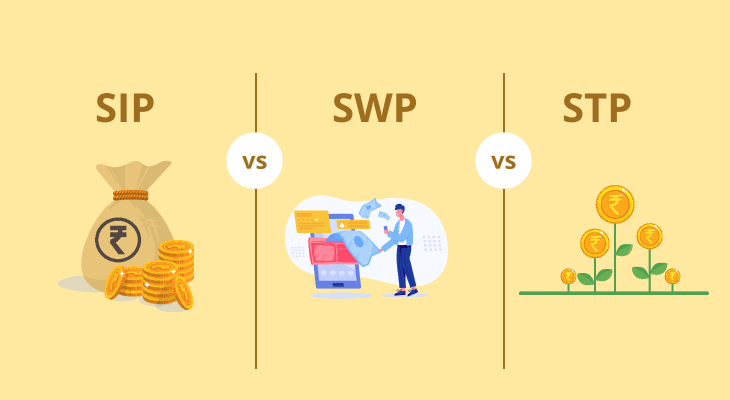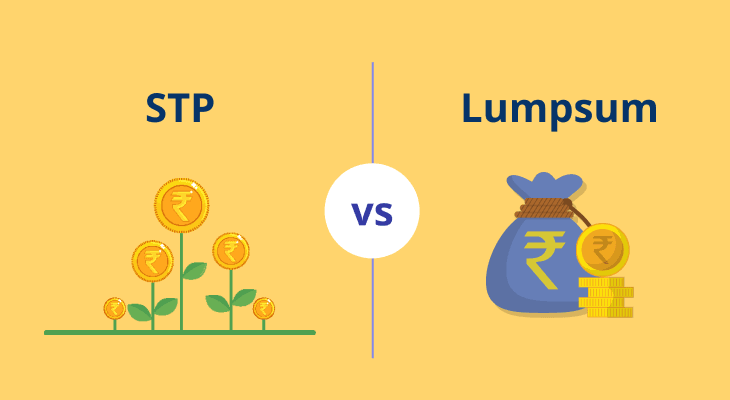
Table of content
- What is a Lumpsum Investment?
- What is SIP?
- SIP vs Lumpsum: An Illustrative Example
- How Much is the Minimum Investment Amount for SIP?
- How Much is the Minimum Investment Amount for Lumpsum?
- Benefits of SIP vs Lumpsum Investment
- Benefits of SIP
- Benefits of Lumpsum
- SIP vs Lumpsum: The Key Differences
- How to Invest in Mutual Funds: SIP vs Lumpsum
- SIP vs Lumpsum: Which is Better?
- Factors to Consider Before Investing in SIP or Lumpsum
- Conclusion
SIP v/s Lumpsum Investment: Which Method is Better?
As a part of your investment journey, you have to make a number of choices and decisions to optimise your returns. One such crucial choice is between SIPs and lumpsum investments. The SIP vs Lumpsum investment dilemma may be an old one, but it continues to concern new investors even today.
If you are at that point in your journey where you need to settle the Lumpsum vs SIP investment issue and make a choice, it can help to first understand how each of these strategies works. Thereafter, you can gain more clarity on the differences between SIP and Lumpsum investments to make a suitable choice.
What is a Lumpsum Investment?
A Lumpsum investment is a strategy where you invest a large sum of money in an asset or a scheme. This is typically a one-time investment, and the amount invested is locked in the asset for a specific tenure. You then earn returns on the Lumpsum amount invested in the form of interest or capital appreciation.
A fixed deposit (FD) is an excellent example of a Lumpsum investment. Here, you make a one-time deposit and earn interest on that amount over the FD tenure. This interest may be paid out periodically or reinvested in the deposit, depending on your preferences.
What is SIP?
A Systematic Investment Plan (SIP) is a strategy where you invest small sums of money in an asset or a scheme periodically, at regular intervals. You can make these small yet regular investments for a tenure of your choice, depending on the asset. The amounts invested continue to grow exponentially due to the power of compounding, thus generating returns.
SIPs are most commonly used to invest in mutual fund schemes. You can invest as little as ₹500 each month in the mutual funds of your choice and diversify your portfolio over the years.
SIP vs Lumpsum: An Illustrative Example
To decide which is better — SIP or Lumpsum investing, let us take up some hypothetical numbers to see how the returns would vary with each investment strategy.
Scenario 1: You Make A Lumpsum Investment Of ₹2.40 Lakhs In A Mutual Fund
Let’s say the NAV on the date of investment is ₹10. So, you will receive 24,000 units in the fund when you make your Lumpsum investment. At the end of 1 year, say the NAV is ₹10.90. In this case, your investments would have grown to ₹2,61,600 (24,000 units X ₹10.90).
This means your total gains would amount to ₹21,600, which translates to returns at the rate of 9%.
Checkout our Lumpsum Calculator for better understandingScenario 2: You Make Regular Monthly Investments Of ₹2.40 Lakhs In A Mutual Fund Via A SIP
Let’s say the NAV of the fund varies as follows for the first 12 months of your SIP.
Month
Amount Invested via a SIP
NAV on the Date of Investment (Assumed)
Number of Units Allotted (Investment Amount ÷ NAV)
1 ₹20,000 ₹10.00 2,000.00 2 ₹20,000 ₹10.55 1,895.73 3 ₹20,000 ₹10.20 1,960.78 4 ₹20,000 ₹9.55 2,094.24 5 ₹20,000 ₹9.44 2,118.64 6 ₹20,000 ₹9.32 2,145.92 7 ₹20,000 ₹9.25 2,162.16 8 ₹20,000 ₹9.10 2,197.80 9 ₹20,000 ₹9.45 2,116.40 10 ₹20,000 ₹9.85 2,030.46 11 ₹20,000 ₹10.50 1,904.76 12 ₹20,000 ₹10.90 1,834.86 Total
₹2,40,000
-
24,461.77
Here, the total amount you have invested is still ₹2,40,000. And you have been able to purchase a total of 24,461.77 units with this sum over the course of 12 months, making the average cost of investment ₹9.80 per unit. This is how rupee cost averaging works.
As for the returns, at the end of 12 months, your investments would have grown to ₹2,66,633.29 (24,461.77 units X ₹10.90). This means your total gains would amount to ₹26,633.29, which translates to returns at the rate of 11.097%.
Checkout our SIP Calculator for better understanding
How Much is the Minimum Investment Amount for SIP?
If you're new to investing or prefer small, regular contributions, SIP offers a highly accessible way to start. You can begin with a modest amount and gradually build your portfolio over time.
Most mutual fund houses in India allow you to start a SIP with as little as ₹ 100 per month, although ₹ 500 is the more commonly accepted amount. This low entry barrier makes SIPs ideal for new investors, salaried individuals, or anyone looking to build wealth steadily over time. You can increase your SIP amount later, depending on your financial capacity, or even set up step-up SIPs to match your income growth.
How Much is the Minimum Investment Amount for Lumpsum?
Lump sum investments are suited for individuals who have surplus funds or want to invest a larger amount in one go. While the entry amount is still low, this option is more about intent and strategy.
For lump sum investments, the minimum amount generally starts at ₹ 1,000. It's commonly used when investors receive bonuses, inheritances, or maturity proceeds. Unlike SIPs, lump sum investing requires timing the market more accurately, which can be risky without a strong understanding of market conditions.
Benefits of SIP vs Lumpsum Investment
Both SIP and lump sum investment styles offer unique advantages, depending on your investment habits, financial situation, and market outlook. Here’s how each one benefits investors in different ways.
Benefits of SIP
SIP brings structure and consistency to your investing, helping you ride out market volatility and build wealth gradually.
- Instils financial discipline by automating your investments every month.
- Rupee-cost averaging reduces the impact of market volatility by spreading purchases over time.
- Affordable and flexible, making it easy to start small and scale up later.
- Ideal for long-term financial goals like retirement or a child’s education.
- No need to time the market, which reduces stress and the risk of poor decision-making.
- Can be paused, increased, or stopped anytime, depending on your cash flow and goals.
Benefits of Lumpsum
Lump sum investing allows you to deploy a large amount of money at once, helping you make the most of favourable market opportunities.
- Maximises potential returns if invested during market lows or bullish phases.
- Fully utilises available surplus like bonuses, inheritance, or savings.
- No need for ongoing scheduling or monthly deductions, keeping it simple.
- Useful for short-term opportunities or when you're confident in the market direction.
- Good for seasoned investors who are comfortable with timing the market.
SIP vs Lumpsum: The Key Differences
The example above illustrates how SIPs, when done right, can generate higher returns and reduce the average cost of investment. Let us now take a closer look at the key differences between SIP and lump sum investments.
Particulars | SIP | Lump Sum Investment |
|---|---|---|
Frequency of investment | Regular | One-time |
Investment costs | Lower due to rupee cost averaging | May be higher |
Risk profile | Low to medium | Medium to high |
Effect of market volatility | Low or negligible | Significant |
Investment flexibility | High | Low |
Suitable time horizon | Short-term to medium-term | Long-term |
How to Invest in Mutual Funds: SIP vs Lumpsum
Whether you invest via SIP or lump sum, the basic mutual fund investment process remains the same. The key difference lies in how and when you choose to allocate your funds.
Steps to Invest in Mutual Funds:
- Identify your financial goals such as retirement, home purchase, education, etc.
- Assess your risk appetite and choose equity, debt, or hybrid funds accordingly.
- Complete KYC formalities through an AMC, distributor, or online investment platform like m.Stock.
- Select a mutual fund scheme based on performance, expense ratio, and fit with your goals.
- Decide the investment mode like SIP for regular contributions, or lump sum for one-time deployment.
- Make the payment online via UPI, net banking, or auto-debit instruction.
- Track your investments regularly through statements or app dashboards.
- Review and rebalance annually to stay aligned with your changing life needs.
Whether you choose SIP or lump sum, most platforms allow you to start, pause, switch, or redeem easily. Remember, m.Stock allows you to make direct mutual fund investments with zero commissions helping you pocket more of your returns.
SIP vs Lumpsum: Which is Better?
Now that you know the details of the SIP vs lump sum comparison, let us determine which of these may be better for you.
A lump sum investment may be suitable for you if you have a large sum of money in hand, and if you want to invest it in a gainful manner. It may also be ideal to choose a lump sum investment if the market is trending upward since you can lock in a lower investment cost.
On the other hand, a SIP may be better for you if you do not have a lump sum saved up and if you want to start investing anyway. Additionally, if the market is trending downward, you can use a SIP to take advantage of falling NAVs.
Factors to Consider Before Investing in SIP or Lumpsum
Before you choose between SIP or lumpsum, take time to evaluate a few important factors. These can influence your returns and risk exposure in the long run.
- Availability of funds: SIP is ideal for regular income earners, while lump sum suits one-time large funds.
- Market timing: SIP removes the pressure of timing the market, unlike lump sum where entry point matters.
- Risk tolerance: SIP offers smoother returns over time, reducing volatility risk.
- Investment horizon: Both work well for long-term goals, but SIP offers better discipline.
- Tax treatment: Taxation rules remain the same, but investment behaviour can affect real returns.
Investment experience: SIP is beginner-friendly, whereas lump sum needs more awareness.
Conclusion
Now that you have a clearer picture of the differences between SIP and Lumpsum investments, you can weigh the pros and cons and figure out what works best for you. That said, it does not always have to be a choice between these two options. You can even invest a lump sum amount in one asset and start a SIP in another. This will help you tap into the advantages of both SIPs and lump sum investments.
SIPs let you invest small amounts regularly, making it easier to stay consistent with your goals. With time, your money grows faster through compounding, helping you get the most out of your investments. Try our SIP Calculator to see how your money can grow and make smarter plans for your future.
FAQ
Are tax rules different for SIP and lump sum?
Tax rules are based on the duration for which your units are held, not the mode of investment. SIP instalments are treated as individual investments with separate holding periods, while a lump sum investment has one single holding period. Both follow equity or debt taxation norms based on the fund type.
Does compounding work differently in SIP vs lump sum?
Compounding works in both SIP and lump sum, but in different ways. In lump sum, the entire amount starts compounding immediately. In SIPs, compounding happens on each monthly investment, with earlier SIPs compounding longer. Over time, both can generate wealth, though SIPs benefit more from disciplined contributions and volatility averaging.
When should I choose lump sum over SIP?
Lump sum is ideal when you have a large idle corpus and expect a rising market trend. It can maximise returns if the timing is right. It’s also useful for investors with high-risk tolerance or long investment horizons. However, consider using a staggered approach or STP if markets are volatile.
Can SIP and lump sum investments be switched to each other within the same fund, and what are the implications?
You cannot convert a SIP into a lump sum or vice versa directly. However, you can stop a SIP and invest additional funds as a lump sum, or start a SIP in a fund where you earlier invested lump sum. Tax implications, lock-in periods (in ELSS), and exit loads must be considered before switching modes.
Can I switch from SIP to lump sum in the same fund?
Technically, you can stop future SIP instalments and invest a lump sum in the same fund, but it’s not a switch per se. Each investment is treated separately for taxation and redemption purposes. Always review your goal, liquidity needs, and market outlook before altering your investment strategy.
Is SIP better suited for first-time investors?
Yes, SIP is especially recommended for first-time investors as it allows starting small, builds a habit of regular investing, and reduces market entry risk. It also helps understand market dynamics gradually without committing large sums upfront, making it a lower-stress way to enter mutual fund investing.
Is there a difference in NAV between SIP and lump sum?
No, there is no difference in NAV offered to SIP or lump sum investors. Everyone investing on the same day gets units at the same NAV. However, SIPs average out the NAV over time due to multiple purchase dates, while lump sum locks in the NAV on a single purchase date.
Can I stop or pause my SIP at any time?
Yes, most SIPs offer the flexibility to pause or stop without penalty. You can request this through your fund house or platform before the next instalment date. However, stopping SIPs frequently may disrupt your financial goals, so decisions should be based on planning, not market fear.


